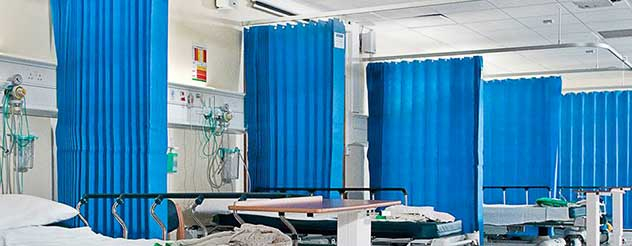Disposable hospital privacy curtains are providing more than just a barrier to the spread of infections.

In recent years traditional fabric curtains have all but disappeared from UK hospitals, replaced by disposable alternatives in a move largely driven by infection prevention protocols.
A spokesman for manufacturer, Grosvenor Contracts, explains: “Traditional fabric curtains act as a breeding ground for harmful bacteria, need regular cleaning, and also suffer from wear and tear.
“Modern disposable cubicle curtains are not only superior in the fight against hospital acquired infections; but also offer best value for healthcare providers.”
An important role
Steve Parker, manufacturing manager at Marlux Medical, adds, “One of the most important practical benefits of disposable curtains is their role in helping to reduce infection rates, alongside strict handwashing regimens and vigilance over the environment and patient care.”
Marlux manufactures both treated and untreated curtains, the former being more suited to rapid-turnaround areas where there is a lower infection risk or where the curtains are more-frequently replaced.
Like Grosvenor products, all are made from polypropylene, which inhibits the growth of infections.
In addition, the Marlux treated curtains contain Microban antibacterial technology, which kills up to 99.99% of harmful bacteria on the surface.
This attention by manufacturers to infection prevention and control is making disposable products increasingly more popular than traditional linen alternatives, which, due to their weight, will almost inevitably come into contact with the floor during the hanging process, resulting in the curtain being contaminated even before it is hung.
Other practical benefits over linen curtains
Maintenance regimes
It is generally accepted across the industry that curtains – both linen and disposable – should be changed once every quarter but “with hospitals coming under increasing budget constraints, we are seeing some customers who previously changed their disposable curtains once a quarter now considering a change to once every six months,” said Parker.
“This will be acceptable if the area and usage is appropriately risk assessed.”
To help ensure products are changed in line with the recommendations, most modern ranges include a date section on the label, which acts as a visual indicator to clinical and maintenance staff.
After removal
Many manufacturers offer a free recycling service for curtains which are not classed as clinical waste, another key consideration for trusts charged with reducing their carbon footprint.
And it’s not just the curtains themselves that are being modernised to meet the needs of healthcare operators.
Tracking systems innovations
Grosvenor have developed three hook types as well as an eyelet range. Thus enabling curtains to be quickly and easily fitted to existing cubicle tracking system with minimum disruption and no need for costly adaptations, a key advantage in 24/7 clinical environments.
Similarly, Marlux’s Adapt-a-Track system enables all existing tracking systems to be converted for use with its Fast-Fit range.
Maintaining tracking
Parker advises specifiers to regularly maintain curtain tracking.
“Track runners should be cleaned and silicone should be reapplied to the track every time a new curtain is fitted, or once every six months as a minimum.”
Colour ranges
With the interior design of hospitals taking on a more hotel-like feel in recent years, manufacturers are offering curtains in a variety of colours.
Future trends
R&D is expected to focus increasingly on fire regulations, with Marlux taking the decision last year to remove all thread from its curtains following tests that demonstrated the impact of thread on the spread of fires.
“We were the first in the industry to invest in an ultrasonic welding process, which we now use on all our curtains in place of thread,” explains Parker. He believes other manufacturers will follow suit in the future.”
Keeping up with trends
And he predicts interior design trends will also continue to impact on design, adding: “We predict a shift towards greater customisation that goes beyond colour choice to include the option to print messages or images on the material.
“Recognising the potential benefits we recently invested in in-house printing facilities. This opens up opportunities for customised curtains for certain hospital wards – children’s wards being a good example – and also to share messages relating to hygiene and patient privacy", says Parker.